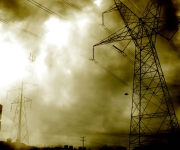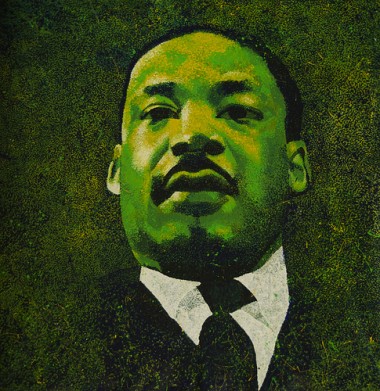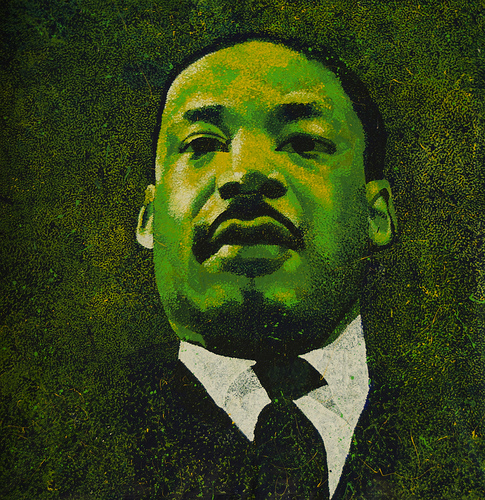Forty-four years after Dr. Martin Luther King, Jr., was shot dead while supporting sanitation workers in Memphis, his legacy is indisputable. Because of the way he mobilized the poor and the powerful, state-sponsored racial discrimination, a prominent factor in American life for nearly 200 years, is no more. As a result, it’s now hard to imagine a position of prominence in this country, including the presidency, that an African American could not obtain.
But Dr. King’s work is not complete. Today, we face continued attempts at voter suppression, attacks on collective bargaining rights, income inequality, a racially inflected discussion of illegal immigration, and one of the last great bastions of state-sponsored discrimination: the denial of marriage and other rights on the basis of sexual orientation. If Dr. King were alive today, I believe he would speak out about these issues. I believe, too, that in this era of globalization, he would talk about climate change, the North/South divide, and our moral duty to preserve the natural resources that are fundamental to human wellbeing.
Dr. King would be an environmentalist, but I think he would talk about the natural and man-made worlds in a way that resonates with everyone, especially the poor. Let me explain.
I spent most of my childhood on the eastside of Baltimore, part of a black family living paycheck to paycheck in the shadow of one of the world’s great medical research institutions, Johns Hopkins Hospital. Unfortunately, the health and prosperity of Hopkins rarely spilled over into the surrounding community. On our side of the invisible line, urban decay and drug-related crime defined the landscape. Three out of every ten houses in my neighborhood were vacant.
These two very different communities viewed each other warily. I attended Johns Hopkins University on scholarship as an undergrad, worked part-time as an office assistant in the department of anesthesiology and critical care medicine, and was there when a division chief within the department was robbed and assaulted on his way home. I can’t remember speaking to anyone else in that office who lived within the city limits, let alone near the hospital, and I think that attack reinforced the idea that Hopkins was by necessity a fortress, a place apart.
The fear ran both ways. My grandmother summed up many residents’ concerns about the hospital down the street. “I have friends who go into Hopkins,” she once told me, “but they don’t come out.” There was a lot to this statement. For people with little or no access to healthcare, an acute illness left untreated for years can become chronic and eventually irreversible. Add this to glaring disparities in wealth and cultural barriers, and it becomes plausible for a 70-year-old woman from the segregated South to believe that white men in lab coats might kill her if they had the chance.
After years of trying to solve the problem of the surrounding community, the hospital settled on a solution: They tore much of it down. Hopkins and the City of Baltimore formed a partnership called East Baltimore Development Inc., used eminent domain to relocate my grandmother and hundreds of other families, and cleared 88 acres to make room for a biotechnology park.
What does all this have to do with the environment? In 2006, when a local magazine asked me and a pair of artists to fill two pages of a special issue with anything we wanted, the story of my troubled neighborhood was on my mind. Why was the city so racially divided, we asked, and was there anything we could do about it? Our attempt to answer that question became a small environmental campaign called Black + White = Green. The idea was that even though the most outspoken proponents of environmentalism were white and the victims of environmental degradation were disproportionately black and brown, the environment could give us lots of common ground, especially if we expanded its definition to include the material and non-material factors that shape life everywhere, from untouched mountain tops to the streets of inner cities.
I don’t think any of us had much experience working on environmental issues, so we embarked on this project with no knowledge of people who were already doing what we had in mind in much bigger and better ways. There’s Will Allen, a Milwaukee-based MacArthur Foundation “genius” award winner who’s turning young people into urban farmers; former Obama administration green jobs advisor Van Jones, connecting environmentalism to community development and economic opportunity; and Majora Carter, another MacArthur “genius,” busy greening New York’s South Bronx.
Tactically and philosophically, these are some of the descendants of Dr. King. As if reading from King’s playbook, Jones in particular has made a point of empowering young people; fighting for economic opportunity; using collective action; helping those who might otherwise be written off as powerless turn their hands and feet into assets; and paying close attention to the way America thinks and talks about itself. In his latest project, called Rebuild the Dream, Jones is encouraging environmentalists, community activists, and average citizens to demand economic fairness. His timing was perfect. Rebuild the Dream was up and running as the Occupy movement kicked into full gear, and it soon became clear that Jones, the urban environmentalist, already spoke the demonstrators’ language.
Last October, when occupiers were making news daily, I attended a forum in Washington, D.C. A new monument to King had been erected in the National Mall and civil rights veterans gathered to remember King and his work. The speakers repeatedly drew connections between their departed friend’s push for economic equality and the Occupy movement. The parallels were striking.
King spent his last months organizing a Poor People’s Campaign that, just weeks after his death, saw the erection of a settlement in the capital full of people demanding an end to poverty. It’s impact was small. King was killed before the march took off on Mother’s Day 1968, the assassination of Robert Kennedy dampened spirits during the encampment’s third week, and in mid-June the Department of the Interior forced the demonstrators to leave after their permit expired.
Dr. King has now been dead for several more years than he ever spent walking, teaching, and preaching, but lots of people of different colors and backgrounds are still looking for a way forward. Now, as then, progress in some areas is still elusive, but the events of the past year show that thousands are willing to work for change.
Forty-four years after his death, Occupy, people like Van Jones, and the resonance with which King’s voice still reverberates through current events, all suggest that a movement that can unite people who care about patches of soil with those who know how cold and unforgiving a swath of concrete can be, could bring us that much closer to something that looks like justice.





